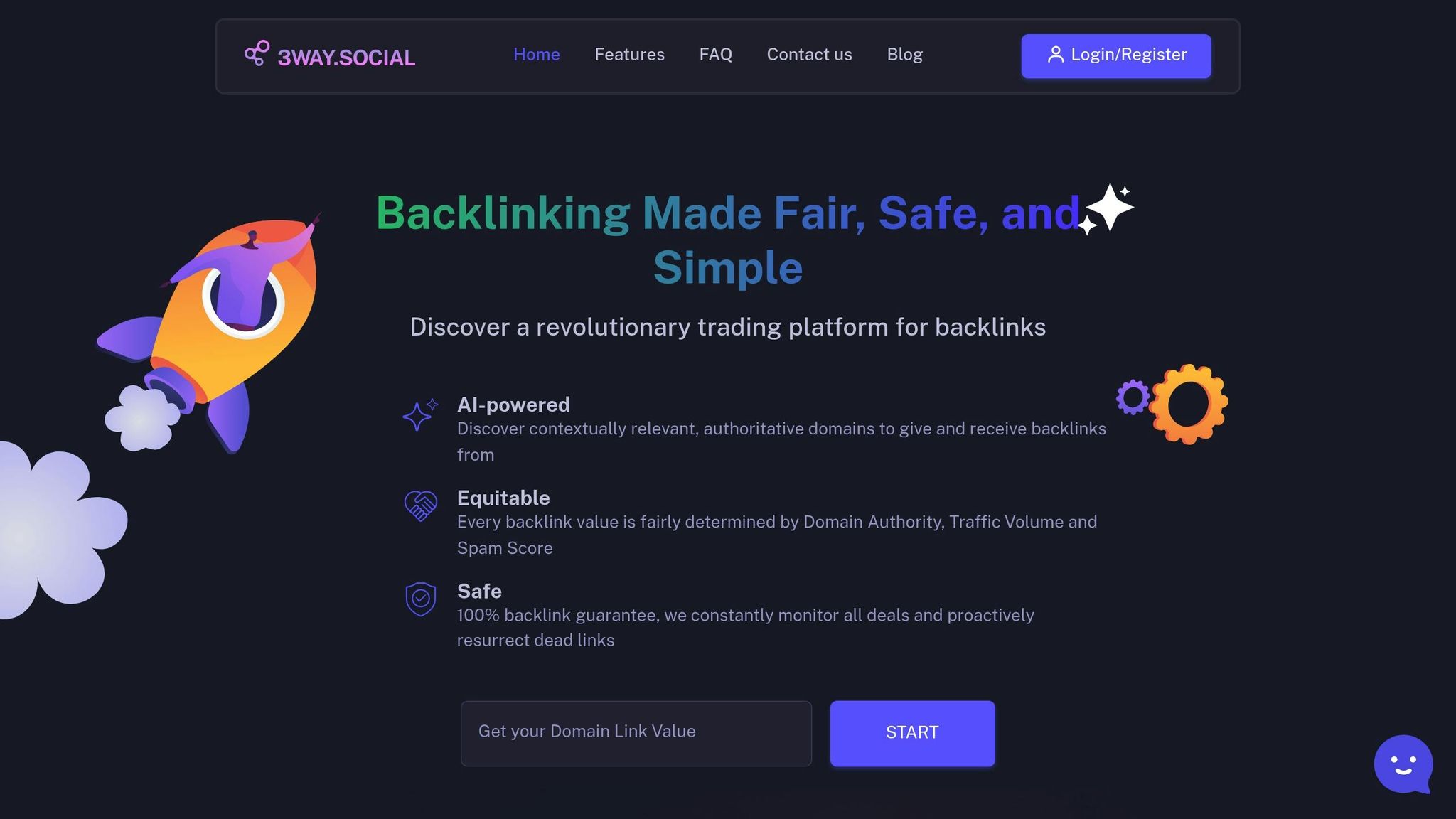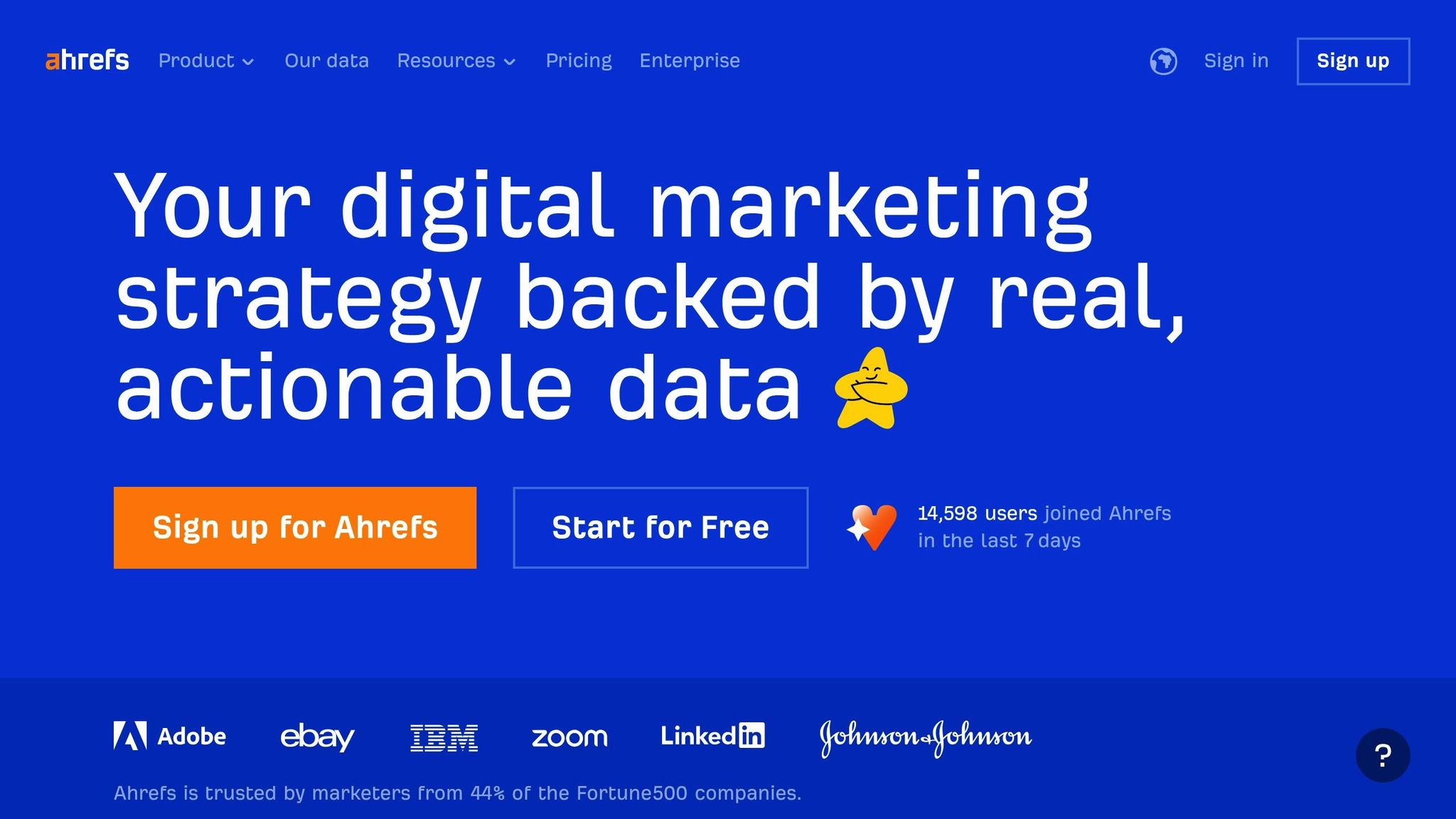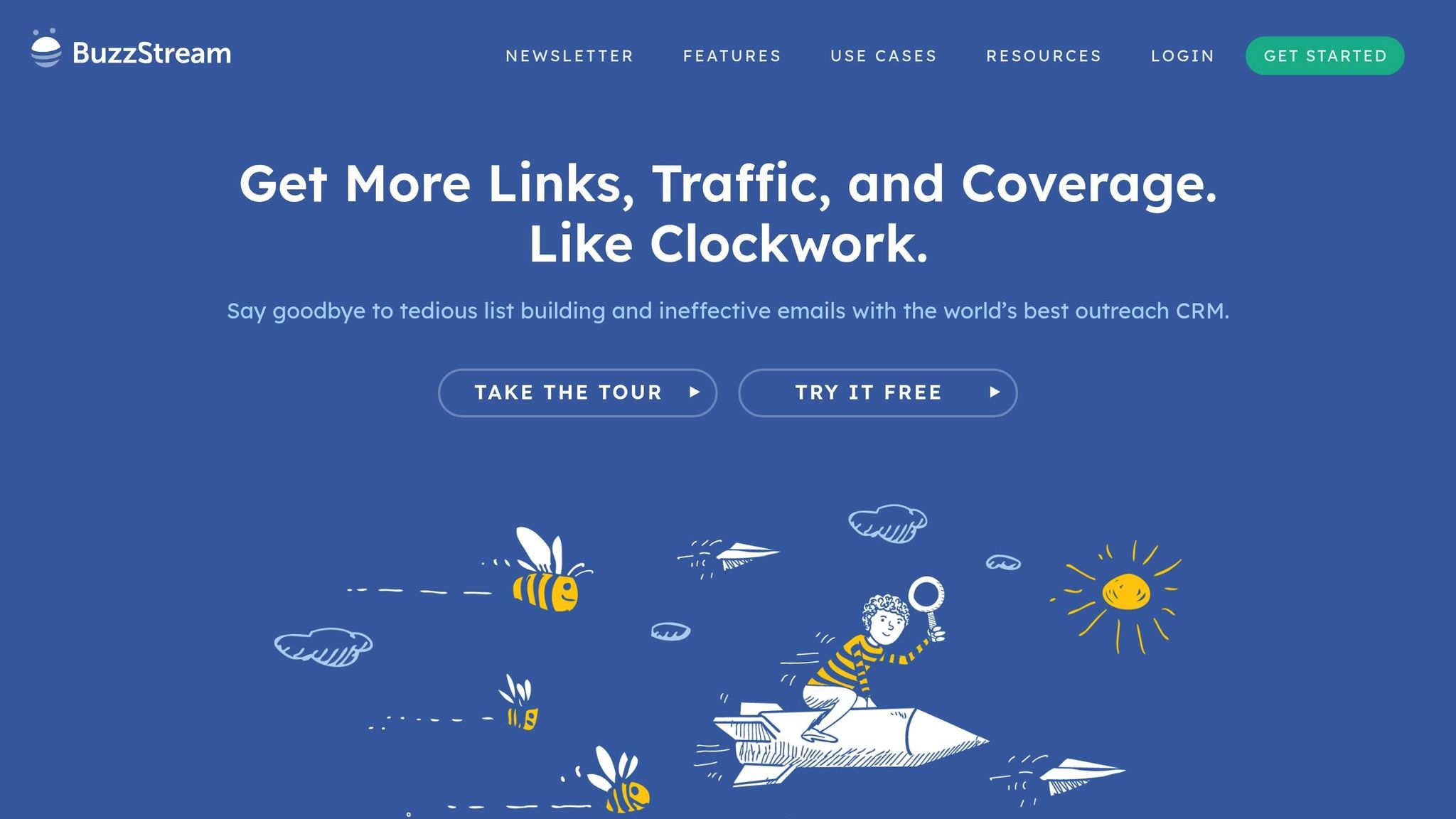Last Updated on June 23, 2025 by Becky Halls
SEO link building is the process of getting other websites to link to yours, which helps improve your site’s rankings on Google and drives more visitors. But not all links are equal – quality matters more than quantity. This article breaks down 12 straightforward steps to build better backlinks and boost your SEO performance.
Key Steps to Follow:
- Audit Your Backlink Profile: Use tools like Ahrefs or SEMrush to identify good and bad links.
- Study Competitors: Analyze their backlinks to find opportunities for your site.
- Set Goals: Focus on what you want – higher rankings, more traffic, or better domain authority.
- Find High-Authority Sites: Target websites with strong Domain Authority (DA) and relevant content.
- Check Site Quality: Ensure potential link partners are credible and niche-relevant.
- Use AI Tools: Platforms like 3Way.Social can streamline finding link exchange partners.
- Diversify Links: Combine guest posts, resource pages, and broken link replacements.
- Create Valuable Content: Develop guides, data studies, or infographics that attract natural links.
- Personalize Outreach: Send tailored emails instead of generic pitches.
- Focus on Do-Follow Links: These links pass SEO value, so prioritize them.
- Monitor Links: Track backlinks with tools like Google Search Console or Ahrefs.
- Keep It Balanced: Mix anchor text types and link sources for a natural profile.
Quick Tip:
Use tools like Ahrefs, SEMrush, and BuzzStream to manage your link-building strategy effectively. AI-powered platforms like 3Way.Social can save time and improve results by finding quality link exchange opportunities.
By following this checklist, you’ll create a strong, diverse backlink profile that boosts rankings and drives traffic. Let’s dive in!
Full SEO Link Building Course | How To Build SEO Backlinks in 2025
Preparation Steps Before Link Building
Before diving into link-building efforts, it’s crucial to take a step back and evaluate both your own backlink profile and your competitors’. This initial analysis lays the groundwork for a successful campaign and helps you sidestep potential pitfalls.
Audit Your Current Backlink Profile
Start by assessing your existing backlinks using tools like Ahrefs or SEMrush. These tools help you benchmark your domain authority and pinpoint any quality issues. To keep things organized, create a spreadsheet that includes details like:
- Domain name
- URL
- Anchor text
- Domain Authority (DA) or Domain Rating (DR)
- Spam score
Using color coding can make it easier to spot high-quality links versus problematic ones. Pay special attention to key factors such as DA/DR, spam scores, anchor text patterns, the ratio of follow to nofollow links, and any broken or penalized links. Harmful links should be listed separately and disavowed using Google’s disavow tool.
Additionally, track your website’s performance through Google Search Console to monitor improvements. Highlight links from high-authority domains and cross-reference this data with Google Analytics to see which links are driving referral traffic. Once you have a clear understanding of your own backlink profile, you’ll be better equipped to assess your competitors and find new opportunities.
Analyze Competitor Backlink Strategies
Examining your competitors’ backlink strategies can reveal insights that shape your own approach. Identify 3–5 key competitors targeting similar keywords and analyze their backlink profiles using tools like Ahrefs, SEMrush, or Majestic. Look at both domain-level competitors (those competing with your entire site) and page-level competitors (those ranking for specific pages or keywords).
Pay close attention to backlink gaps – domains linking to your competitors but not your site – as these represent great opportunities for outreach. Study how competitors are securing their links. Are they leveraging guest posts, podcasts, industry directories, or resource pages? Look for recurring patterns and sources that could work for your strategy.
Additionally, identify the types of content that attract the most backlinks for your competitors. This can help you prioritize the kinds of content you should create to boost your chances of earning links. Understanding these trends also provides a realistic benchmark for your goals by clarifying where your site stands in the competitive landscape.
Research supports the value of this approach. For instance, Ahrefs data highlights a clear link between the number of referring domains and increased organic traffic. Similarly, Neil Patel’s findings emphasize that analyzing competitor backlinks can uncover valuable opportunities to improve SEO performance. Regularly monitoring competitor backlink profiles and setting up alerts for new links ensures you stay ahead of emerging trends and opportunities.
SEO Link Building Checklist: 12 Steps
Now that you’ve reviewed your backlink profile and scoped out your competitors, it’s time to put a solid link-building plan into action. This checklist will guide you through 12 steps to help you build a diverse and effective backlink portfolio that can boost your SEO performance.
Set Clear Link Building Goals
Before diving into outreach, it’s crucial to know exactly what you’re aiming for. Having clear goals ensures your efforts stay on track and measurable.
Think about your primary objectives: Are you looking to improve domain authority? Rank higher for specific keywords? Drive more referral traffic? Or perhaps enhance your brand’s visibility? For example, if your site currently attracts 10,000 monthly visitors, you might aim to grow that to 15,000 in six months. Breaking larger goals into smaller, actionable milestones with deadlines can help keep you focused.
Track progress with key performance indicators (KPIs) like the number of backlinks you acquire, the quality and relevance of those links, increases in referral traffic, and keyword ranking improvements. Fun fact: 67.3% of SEO experts favor digital PR for link building, and over half spend at least $300 per link.
Once your goals are set, it’s time to hunt for high-quality link opportunities.
Find High-Authority Link Opportunities
When it comes to backlinks, quality always beats quantity. Focus on websites that have solid domain authority, publish relevant content, and engage with audiences similar to your target market. Tools like Ahrefs or SEMrush can help you identify domains with strong metrics – look for sites with Domain Authority (DA) or Domain Rating (DR) scores of 70 or higher.
Target sites that align with your industry. Check for active content updates, social media engagement, and editorial standards. Websites with lively comment sections, regular social shares, and fresh content tend to provide more valuable link opportunities.
Don’t limit yourself. Explore options like respected industry publications, educational (.edu) and government (.gov) sites, well-established blogs, or curated resource directories. Each type of site offers distinct benefits and may call for a tailored outreach approach.
Check Websites for Relevance and Quality
Relevance often outweighs sheer authority. A backlink from a niche blog that aligns with your industry can carry more weight than one from a high-DR site that isn’t related to your content.
Evaluate potential link partners by reviewing their content quality, design, and user experience. Look for unique, well-researched, and engaging articles. Use tools like Ahrefs to analyze their backlink profile and ensure they’re connected to other reputable sites. Social engagement metrics like shares and comments can also provide insight into their audience’s interest.
Steer clear of sites with poor-quality content, excessive ads, or unstable traffic trends.
Use AI for Domain Matching
Platforms like 3Way.Social use artificial intelligence to simplify the process of finding link exchange partners. By analyzing factors like domain authority, niche relevance, traffic patterns, and link equity, AI tools can suggest the most suitable matches for your site.
These tools can also detect natural linking patterns, helping you maintain a balanced and authentic backlink profile. Over time, their recommendations become even more precise.
Diversify Your Link Types
A well-rounded backlink profile includes a mix of link types from various sources. Here are some ways to diversify:
- Guest posts: Write insightful, non-promotional articles for relevant blogs in your industry.
- Linkable assets: Create resources like detailed guides, original research, infographics, or tools that other sites will want to reference.
- Broken link building: Identify dead links on high-authority sites and suggest your content as a replacement.
- Directory submissions: Submit your site to reputable directories within your niche.
Mixing these approaches ensures your profile looks natural and well-balanced.
Create High-Value Content for Link Attraction
Content that naturally earns backlinks is a game-changer. Think of creating in-depth guides, original studies, or comprehensive resources that provide more value than anything else out there. This is often referred to as “10x content.”
Visual content like infographics and data visualizations tends to perform especially well because it’s easy to share and enhances other creators’ content. Adding embed codes to your visuals can make sharing even smoother.
Free tools or calculators tailored to your industry are another excellent way to attract backlinks. Once your content is ready, reach out to potential link partners who would find it valuable.
Build Personalized Outreach Campaigns
Generic emails rarely get results. Instead, focus on personalized outreach that speaks directly to the recipient. Tools like BuzzStream can help you manage these relationships and keep track of your campaigns.
Do your homework – reference specific articles or projects, and explain how your content can benefit their audience. Building genuine relationships through thoughtful outreach is much more effective than sending mass emails.
Engage with your targets on social media before reaching out, and follow up politely if you don’t hear back right away.
Get Permanent Do-Follow Links
Do-follow links provide the most SEO value, so prioritize them in your strategy. Aim for permanent placements embedded naturally within content. Links in sidebars or footers are less effective and may not carry the same weight with search engines.
Avoid link schemes or networks that promise quick results. These often involve low-quality or temporary links that can harm your site’s performance in the long run. Quality backlinks take time to build but deliver lasting benefits.
Monitor and Track Link Placements
Keeping tabs on your backlinks ensures they remain active and effective over time. Use tools like Google Search Console, Ahrefs, or SEMrush to monitor your links. Set up alerts to track new backlinks and identify any that are removed.
Record outreach details – contacts, dates, responses, and link statuses – to stay organized. Use Google Analytics to measure referral traffic from your backlinks and identify which ones are driving the most value.
Keep a Balanced Link Profile
A natural backlink profile includes diversity in anchor text, referring domains, and link types. Vary your anchor text with branded terms, exact match keywords, partial match phrases, and generic phrases like “click here.” Most of your anchors should be branded or generic, with occasional keyword-rich variations.
Build links from a variety of domain types, including blogs, news sites, educational institutions, and industry directories. This diversity signals to search engines that your content appeals to a broad audience.
Maintain a mix of follow and nofollow links. While do-follow links are more beneficial for SEO, incorporating nofollow links creates a more natural profile. Balance is key.
sbb-itb-88880ed
Top Tools and Platforms for Link Building
The right tools can make all the difference in your link-building strategy. These platforms play a critical role in executing the 12 steps of an SEO link-building checklist, covering everything from finding opportunities to managing outreach and tracking results.
3Way.Social: AI-Powered Link Building

3Way.Social takes a fresh approach to link building by using artificial intelligence to connect websites for mutually beneficial link exchanges. The platform claims to deliver results 3x faster than traditional methods, with users reporting an average traffic boost of 20% and a 30% increase in domain authority after exchanges. With over 10,000 successful link exchanges under its belt, it’s clear this tool works at scale.
Key features include streamlined partner discovery, permanent do-follow links, and advanced link diversification. Its user-friendly dashboard makes managing links straightforward and efficient.
Ahrefs/SEMrush: Backlink Analysis and Competitor Research

Ahrefs and SEMrush are two of the most widely recognized tools in the SEO world, each offering distinct advantages.
- Ahrefs: With a database of 35 trillion backlinks and a web crawler second only to Google, Ahrefs is a powerhouse for backlink analysis and broken link detection. Using its Site Explorer, you can identify broken links and pitch your content as replacements. For example, one site owner used Ahrefs’ broken backlinks report to secure high-quality backlinks that remain active today.
- SEMrush: SEMrush offers a more comprehensive marketing toolkit, with over 55 tools spanning SEO, PPC, social media, content marketing, and competitor analysis. It’s especially effective for link reclamation and backlink audits. SEMrush is often praised for being beginner-friendly, while Ahrefs provides more technical depth for advanced users.
Both platforms help you assess competitor backlink strategies, find high-authority link opportunities, and audit your backlink profile. Pricing starts at $129/month for Ahrefs and $139.95/month for SEMrush. Choose Ahrefs for a pure SEO focus, but go with SEMrush if you need an all-in-one marketing solution that includes local SEO features.
BuzzStream: Outreach and Relationship Management

BuzzStream simplifies the time-intensive aspects of link building, from finding contact information to managing outreach campaigns and relationships. It centralizes your outreach efforts, keeping your team organized and efficient. Studies show that effective follow-ups can improve success rates by 2–5 times, and BuzzStream makes this process easier with customizable, automated follow-up sequences.
The platform tracks email opens, clicks, and replies, offering data-driven insights to refine your strategy. It also helps you build contact lists and send personalized emails at scale, while its Chrome BuzzMarker extension streamlines prospect research. Reporting tools allow you to monitor campaign performance with ease.
“Buzzstream is hands down the best enterprise class outreach management tool out there. It gives me the easy top down view to make sure we are delivering. I find the tool saves me time and is extremely intuitive.”
– Wil Reynolds, Founder, Seer Interactive
“BuzzStream allows the personalization I really value whilst making our follow-up and cross-project time way more productive.”
– Darren Kingman, Founder
Pricing starts at $24/month for the Starter Plan, $124/month for the Growth Plan (three users), and $299/month for the Professional Plan (six users). By automating repetitive tasks and focusing on personalization, BuzzStream helps you build stronger relationships while saving time.
Best Practices for Link Diversification
Refining your link diversification strategy is key to building a natural and effective backlink profile. A well-rounded approach involves varying your backlinks while maintaining a focus on quality and relevance to improve search rankings.
Use a Mix of Content Formats
Different types of content attract different kinds of backlinks, so incorporating a variety of formats is essential. For example, guest posts can help establish your authority in the industry while generating editorial backlinks. Infographics, on the other hand, are highly shareable visual assets that often get picked up by social platforms and industry blogs.
You can also create resources like guides, case studies, and original research. Comprehensive guides often find a home on resource pages, while original research serves as a reference point for other websites, offering long-term link-building opportunities.
To further diversify, extend your content’s reach by utilizing directories, forums, social media, and even events. This multi-channel approach ensures your backlink profile reflects genuine business activities rather than a solely SEO-driven effort.
Change Anchor Text and Referring Domains
Diversifying anchor text is another critical element of a natural backlink profile. Research shows that varied anchor text correlates with better click-through rates on Google. An analysis of 100,000 URLs ranking in the top 20 revealed that higher-ranking pages tend to have more diverse anchor text profiles.
Here’s a breakdown of anchor text types and their recommended usage:
| Anchor Text Type | Recommended Percentage | Purpose |
|---|---|---|
| Branded | 35–50% | Highlights your brand naturally |
| Partial Match | 15–30% | Adds contextual relevance |
| Generic | 10–15% | Mimics natural language patterns |
| Naked URLs | 5–10% | Directly references your URL |
| Exact Match | Less than 5% | Targets specific keywords |
Incorporating a mix of branded, partial match, generic, naked URLs, and image-based anchor texts helps ensure your profile appears organic. Avoid overusing exact match anchor text, as it can come across as forced and may even lead to algorithmic penalties.
Domain diversity is equally vital. Aim for backlinks from a mix of high- and low-authority sites to create a balanced and authentic profile. This strategy not only enhances credibility but also mirrors the way real businesses naturally acquire links.
Focus on Quality Over Quantity
When diversifying links, prioritize quality over sheer volume. Search engines are increasingly adept at identifying artificial link patterns, so focusing on authoritative and relevant sources is crucial.
While high-authority links hold significant value, links from lower-tier sites also contribute to a natural backlink profile. This balance reflects how real businesses form connections through partnerships, collaborations, and content sharing across various sectors.
To take it a step further, aim for backlinks from different niches within and outside your industry. Cross-industry links often arise from collaborations, event sponsorships, or broadly appealing content. However, relevance should always remain a priority – links should logically tie back to your business or content for maximum impact.
Conclusion: Building a Strong Backlink Profile
With the 12 essential steps we’ve covered, you now have a clear game plan to strengthen your backlink profile and achieve long-term SEO success. Since organic search accounts for 53.3% of internet activity, effective link building isn’t just helpful – it’s critical.
Breaking down link building into a structured checklist transforms what might feel overwhelming into manageable, actionable steps. This includes everything from audits and competitor research to ensuring link quality.
SEO expert Philip Stevens highlights the importance of this, saying, “A higher ranking on search engine results pages (SERPs) means more clicks, more visitors, and ultimately, more opportunities to connect with your audience”.
The 12-step process outlined here serves as your foundation for creating a consistent, efficient strategy to secure high-quality backlinks. Each step builds on the last, guiding you from setting objectives to tracking results, ensuring no part of the process is overlooked.
Modern AI tools also play a key role, offering features like intelligent domain matching and fair link exchanges. These advancements can significantly boost both traffic and rankings.
Digital Marketing Director Jordan Rivera sums it up well:
“The strategic advantage 3WAY.SOCIAL offers is phenomenal. It’s not just a link exchange platform; it’s a comprehensive SEO enhancer, thanks to its diverse, quality-assured network and innovative exchange methods”.
By following these steps consistently, you’re not just building links – you’re building authority. Prioritize genuine relationships, focus on creating valuable content, and keep quality at the forefront. This approach aligns with what search engines value most.
A strong backlink profile is the backbone of SEO success. Stick to the checklist, leverage the right tools, and watch as your rankings and traffic steadily rise.
FAQs
What are the biggest mistakes to avoid when building SEO backlinks?
When working on building SEO backlinks, steering clear of common missteps is essential to protect your site’s performance. Here are a few pitfalls you should watch out for:
- Low-quality or irrelevant links: Getting backlinks from spammy or unrelated sites can harm your reputation and even lead to penalties from search engines.
- Over-optimized anchor text: Using the same keywords repeatedly in your anchor text can come across as unnatural and raise red flags with search engines.
- Buying links: Paying for backlinks goes against search engine guidelines and can result in severe penalties that are tough to recover from.
- Neglecting link relevance: Backlinks work best when they come from websites that align with your content and target audience.
Another mistake to avoid is rushing the process or overlooking the importance of no-follow links. Instead, aim to build ethical, high-quality, and relevant backlinks to strengthen your SEO and ensure your efforts lead to sustainable success.
How can I tell if a website is credible and relevant for building backlinks in my niche?
To determine if a website is a good fit for backlinks, start by checking if its content aligns with your niche or industry. Focus on topical relevance and whether the site’s audience overlaps with your target demographic. This ensures the link will resonate with the right people.
Next, evaluate the site’s credibility. Use tools like Ahrefs or Moz to analyze key metrics such as domain authority, organic traffic, and engagement levels. These indicators help gauge the site’s trustworthiness and overall value.
Lastly, ensure the link will be placed in a relevant and meaningful part of the site – like a blog post or resource page – rather than in unrelated or low-quality sections. Focusing on high-quality, niche-specific domains will make your link-building efforts more effective.
How can AI tools improve the efficiency and success of link-building strategies?
AI tools have become game-changers in streamlining link-building strategies. They handle tasks that typically eat up a lot of time, like outreach and follow-ups, while also analyzing data to pinpoint high-quality link opportunities. On top of that, they offer insights to help fine-tune your strategy. With AI taking care of the heavy lifting, you can dedicate more time to building genuine connections and scaling your efforts with greater efficiency.
These tools are also great for diversifying your backlink profile. They can suggest different content formats – like guest posts, infographics, or other creative options – that align with your audience’s preferences. The result? A more targeted and effective approach to link-building.



